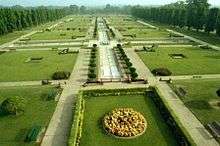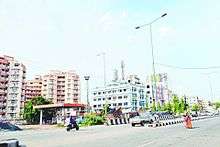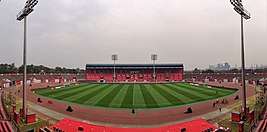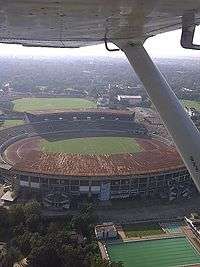Jamshedpur
Jamshedpur (/ˈdʒɑːmʃɛdpɔːr/, ![]()
Jamshedpur Tatanagar | |
|---|---|
| Jamshedpur | |
      Clockwise from top: Sakchi Golchakkar(Roundabout), TCE Building, 1 km Walker's Path (Sonari-Kadma Link Road), View of Tata Steel Plant from JRD Tata Sports Complex, Bat Island in Jayanti Sarovar, JRD Tata Sports Complex | |
| Nickname(s): Steel City | |
 Jamshedpur Location of Jamshedpur in Jharkhand | |
| Coordinates: 22°47′N 86°12′E | |
| Country | India |
| State | Jharkhand |
| District | East Singhbhum |
| Senior Superintendent of Police | Shri Anoop Birthare (IPS) |
| Deputy Commissioner | Shri Amit Kumar (IAS) |
| Founded by | Jamsetji Tata |
| Area | |
| • Metropolis | 224 km2 (86 sq mi) |
| Elevation | 159 m (522 ft) |
| Population (2011) | |
| • Urban | 629,659[2] |
| • Metro | 1,337,131[3] |
| Time zone | UTC+5:30 (IST) |
| PIN | 831001 to 831xxx |
| Telephone code | +91-657 |
| Vehicle registration | JH-05 |
| Literacy | 89.41% |
| Official language[4] | Hindi |
| Second languages | Odia Language, Bengali, Urdu, Bhojpuri, Santhali[5] |
Jamshedpur ranked as 15th cleanest city in India by Swachh Survekshan 2019[6] and was 7th cleanest city of India in 2010.[7] City also ranked as 2nd in India in terms of 'Quality of Life'[8] and 84th fastest growing city of world according to City Mayors Foundation.[9]
It is the headquarters of the East Singhbhum district of Jharkhand and is the 36th - largest urban agglomeration. The city is located in nature's den in Chota Nagpur plateau, surrounded by the picturesque Dalma Hills and bordered by the rivers Subarnarekha and Kharkai.
Etymology
In 1919 Lord Chelmsford named the city, which was earlier a village called Sakchi, to Jamshedpur in honour of its founder, Jamsetji Nusserwanji Tata, whose birthday is celebrated on 3 March as Founder's Day.[10] J. N. Tata had written to his son Dorabji Tata about his vision of a great city in the area. On Founders Day, which is 3 March, the 225-acre (0.91 km2) Jubilee Park is decorated with brilliant lightwork for about a week.[11]
The city has several nicknames, including "Industrial capital of Jharkhand" (spontaneous among native youngsters); "Steel City" (which was referenced during Tata Steel's "Green City—Clean City—Steel City" campaign); "Tatanagar" after the name of its railway station or simply "Tata" in deference to the presence of Tata companies. At one time it was also known as "Kalimati" (meaning "Land of Black soil") after the village near the Sakchi area. Sakchi was renamed to Jamshedpur in 1919.[12] The only trace of the name is the main road through Sakchi area of Jamshedpur which is named Kalimati Road.
History
At the end of the 19th century, Jamsetji Tata met steelmakers in Pittsburgh to get the most advanced technology for his plant. It is said that he got the idea of building a steel plant when he heard Thomas Carlyle declaring that "the nation which gains control of iron soon acquires the control of gold" in a lecture in Manchester.[13] At the turn of the twentieth century, Jamshetji Tata asked geologist Charles Page Perin to help him find the site to build India's first steel plant. The search for a site rich in iron, coal, limestone and water began in April 1904 in today's Madhya Pradesh. Then Maharaja of Mayurbhanj appointed in his court renowned geologist Shri Pramatha Nath Bose, who had been instrumental in setting up of the steel plant at Sakchi. Bose, on the request of the Maharaja of Mayurbhanj, surveyed the Gorumahisani hills of Babanghati region of then Mayurbhanja state, and found Hematite deposit there. P. N. Bose insisted Jamsetji Tata choose Sakchi for his dream plant.
The prospectors C. M. Weld, Dorabji Tata and Shapurji Saklatvala took nearly three years in a painstaking search across vast stretches of inhospitable terrain to find a location. One day they came across a village called Sakchi, on the densely forested stretches of the Chota Nagpur plateau, near the confluence of the Subarnarekha and Kharkai rivers. It seemed to be the ideal choice and the place was selected.[14]
In 1908 the construction of the plant as well as the city officially began.[14] The first steel ingot was rolled on 16 February 1912. It was a momentous day in the history of industrial India.[15]
Jamsetji's plan for the city was clear. He envisioned far more than a mere row of workers' hutments. He insisted upon building all the comforts and conveniences a city could provide. As a result, many areas in the city are well planned and there are public leisure places such as the Jubilee Park. While building the city, Jamsetji Tata had said, "Be sure to lay wide streets planted with shady trees, every other of a quick-growing variety. Be sure that there is plenty of space for lawns and gardens; reserve large areas for football, hockey and parks; earmark areas for Hindu temples, Muslim mosques and Christian churches."
Messrs Julin Kennedy Sahlin from Pittsburgh prepared the first layout of the town of Jamshedpur.[16] What the city looks like today is a testament to their visionary plans.[17] Jamshedpur is the only million plus city in India without a municipal corporation.
Legend has it that in the late 1980s when the state government proposed a law to end the Tatas' administration of Jamshedpur and bring the city under a municipality, the local populace rose in protest and defeated the government's proposal. In 2005, a similar proposal was once again put up by lobbying politicians. The target audience was the working class. A large majority sided with the government and set up protest meetings outside the East-Singhbhum Deputy Commissioner's office. However, the objective was never achieved and Jamshedpur remains without a municipality.[18][19][20]
Geography


Jamshedpur is situated in the southern end of the state of Jharkhand and is bordered by the states of Odisha and West Bengal. The average elevation of the city is 135 metres[21] while the range is from 129 m to 151 m.[22] Total geographical area of Jamshedpur is 209 km square.[23] Jamshedpur is primarily located in a hilly region and is surrounded by the Dalma Hills running from west to east and covered with dense forests. The other smaller hill ranges near the city are Ukam Hill and the Jadugoda-musabani hill range.[24] The city is also a part of the larger Chota Nagpur Plateau region. The region is formed of the sedimentary, metamorphic and igneous rocks belonging to the Dharwarian period.
Jamshedpur is located at the confluence of Kharkai and Subarnarekha Rivers. Subarnarekha is the principal river of Jamshedpur, which flows from west to south-eastern part of the territory. Many small rivers, especially the tributaries, join the Subarnarekha river in this area. Kharkai flows from the south and joins the Subarnarekha river at a place called Domuhani. The two rivers are the major sources of drinking water and groundwater for the city. Several lakes of varying size are also located near the fringes of the city. The major of them being the Dimna lake located in between the Dalma range and the Sitarampur reservoir situated beside Kharkai river. It's also a major tourist spot in the region.[25] Both of them also act as reservoirs for drinking water in the city.
The city falls under deciduous type of forest region and the green cover is estimated to be around 33% of the total land area.[26] The city falls under the Seismic Zone II region.[27]
Climate
Jamshedpur features a tropical wet and dry climate (Köppen: Aw). Summers start in mid-March and can be extremely hot in May and June. The temperature variation during summer is from 35 to 49 °C (95 to 120 °F). The minimum temperature during winters is 5 °C (41 °F). The climate of Jamshedpur is marked by south-west monsoon. Jamshedpur gets heavy rainfall from July to September and receives about 1,200 mm (47 in) of rainfall annually.
| Climate data for Jamshedpur, India (1981–2010) | |||||||||||||
|---|---|---|---|---|---|---|---|---|---|---|---|---|---|
| Month | Jan | Feb | Mar | Apr | May | Jun | Jul | Aug | Sep | Oct | Nov | Dec | Year |
| Record high °C (°F) | 33.4 (92.1) |
39.4 (102.9) |
42.6 (108.7) |
45.7 (114.3) |
47.7 (117.9) |
47.2 (117.0) |
40.0 (104.0) |
39.6 (103.3) |
37.9 (100.2) |
38.2 (100.8) |
35.6 (96.1) |
33.5 (92.3) |
47.7 (117.9) |
| Mean maximum °C (°F) | 31.1 (88.0) |
35.1 (95.2) |
39.8 (103.6) |
43.2 (109.8) |
43.3 (109.9) |
41.1 (106.0) |
36.4 (97.5) |
35.8 (96.4) |
35.6 (96.1) |
35.3 (95.5) |
33.2 (91.8) |
30.7 (87.3) |
43.8 (110.8) |
| Average high °C (°F) | 27.0 (80.6) |
30.3 (86.5) |
35.2 (95.4) |
39.2 (102.6) |
38.9 (102.0) |
36.0 (96.8) |
32.9 (91.2) |
32.6 (90.7) |
32.9 (91.2) |
32.7 (90.9) |
30.6 (87.1) |
27.7 (81.9) |
33.0 (91.4) |
| Average low °C (°F) | 11.8 (53.2) |
15.1 (59.2) |
19.4 (66.9) |
23.8 (74.8) |
26.0 (78.8) |
26.3 (79.3) |
25.9 (78.6) |
25.8 (78.4) |
25.3 (77.5) |
22.3 (72.1) |
16.8 (62.2) |
12.4 (54.3) |
20.9 (69.6) |
| Mean minimum °C (°F) | 7.7 (45.9) |
10.5 (50.9) |
14.7 (58.5) |
19.6 (67.3) |
21.7 (71.1) |
23.2 (73.8) |
23.9 (75.0) |
24.2 (75.6) |
23.6 (74.5) |
17.7 (63.9) |
12.7 (54.9) |
8.7 (47.7) |
7.9 (46.2) |
| Record low °C (°F) | 3.9 (39.0) |
5.0 (41.0) |
10.3 (50.5) |
16.0 (60.8) |
19.0 (66.2) |
19.8 (67.6) |
21.4 (70.5) |
21.4 (70.5) |
18.7 (65.7) |
13.7 (56.7) |
6.1 (43.0) |
4.4 (39.9) |
3.9 (39.0) |
| Average precipitation mm (inches) | 11.6 (0.46) |
22.8 (0.90) |
25.0 (0.98) |
34.0 (1.34) |
78.9 (3.11) |
248.5 (9.78) |
316.5 (12.46) |
310.0 (12.20) |
232.9 (9.17) |
73.7 (2.90) |
10.3 (0.41) |
8.2 (0.32) |
1,372.4 (54.03) |
| Average rainy days | 1.3 | 1.6 | 1.8 | 2.6 | 5.2 | 10.5 | 15.4 | 15.7 | 11.3 | 4.3 | 1.0 | 0.7 | 71.4 |
| Source: [28] | |||||||||||||
Economy

Jamshedpur is home to the first private iron and steel company of India. The areas surrounding Jamshedpur are rich in minerals, including iron ore, coal, manganese bauxite and lime.
Tata Steel (the erstwhile Tata Iron and Steel Company or TISCO), situated almost at the centre of the city. Tata Steel is the largest iron and steel producing plant in India, as well as the oldest.[29] It has been recognised as the best integrated steel plant twelve times; having won the PM's Trophy ten times and received the Certificate for Excellence twice.
Tata Motors earlier it was known as Tata Engineering and Locomotive Company, which used to manufacture the railway locomotives and now manufactures heavy vehicles trucks.
It is also home to TATA Cummins Pvt. Limited, Tayo Rolls Limited (defunct),[30] TRF.Ltd, JUSCO, The Tinplate Company of India Limited, Tata Powers, Nuvoco Vistas Corporation.Ltd (earlier Lafarge Cement), Linde plc (it is one of Asia's largest Air Separation units, Praxair, Tata Hitachi Construction Machinery, Tata Ryerson (J.V of Tata Steel-Ryerson), Timken India (J.V of Tata Steel-Timken), Tata Bluescope (J.V of Tata Steel-BlueScope), Tata Steel Growth Shop (TGS), Tayo Rolls, Tata Pigments, Tata Tubes, Indian Steel and Wire Products Limited, UCIL and Thriveni Earthmovers Pvt Limited.
Apart from the above large corporates, Jamshedpur has a varied and powerful industrial base established at Adityapur Industrial Area (managed by AIADA). Jugsalai is key market for wholesalers while Sakchi is popular retail low cost market.
Demographics
According to the 2011 census of India, the city of Jamshedpur had a population of 629,659,[2] but the Jamshedpur Urban Agglomeration had a population of 1,337,131.[3] The city is designated as a Million Plus Urban Agglomeration as per Government terminology.[31] Males constitute 52.1% of the population and females 47.9%. Tribals constitute around 28% of the population. Jamshedpur has an average literacy rate of 89.41% – higher than the national average of 74%. In Jamshedpur, 11.5% of the population is under six years of age.[32]
Civic administration

The civic administration of the city is under Greater Jamshedpur Metropolitan Region, Govt of Jharkhand.
The major urban local bodies are :

- Jamshedpur Industrial Town
- Jamshedpur Notified Area Committee (JNAC)
- Mango Municipal Corporation
- Adityapur Municipal Corporation
- Jugsalai Nagar Parishad
- Kapali Nagar Parishad
Transportation
Railways

Tatanagar Junction is a railway junction and an A-1 category model station on the Chakradharpur division, of the South Eastern Railway. Other railway stations in the city are Adityapur, Gamharia, Kandra, Govindpur etc.
Roadways
.jpg)

Jamshedpur is connected to other parts of India through national and state highways. The major highways are:
- National Highway 33 (NH-33) touches the city and connects it to Mumbai and further joins the NH32, which connects with Kolkata, Delhi NH-2, NH-33 and NH-6 connects it to Kharagpur, Kolkata.
- National Highway 32 (NH-32) connects Jamshedpur to Dhanbad, Via Bokaro.
- Tata-Kandra Road connects Jamshedpur to Kandra via Gamahria.
- Marine Drive, Jamshedpur connects Adityapur Toll Bridge to Mango via Kadma, Sonari through the western corridors of Jamshedpur
Airport
Sonari Airport is serving the city at present. It is spread over a 25-acre area in the Sonari area of the city. The airport is primarily used for bringing in chartered planes of TATA group.In previous days there were flights from jamshedpur to kolkata.
Dhalbhumgarh Airport is a proposed public airport located at Dhalbhumgarh, in the state of Jharkhand, India as a Greenfield airport for Jamshedpur. It will be built on the site of an abandoned World War II airfield situated 60 kilometres from Jamshedpur on NH-33. The old airfield was built around 1942, as an ancillary runway for other airfields in the vicinity that were being built around India's eastern frontier as part of the war effort. It was one of the airfields used by Allied forces to repel the advancing Japanese troops and to maintain transport links with China. As the Japanese forces came to control shipping in the China Sea, seaborne supply routes to China were cut and the difficult, 500 km route over the Himalayas was increasingly used. The airfield was abandoned after the war.
The technical team of the Airports Authority of India (AAI) conducted survey in 2017 and approved the Dhalbhumgarh site for a greenfield airport. The government plans to invest Rs 300 crore through AAI for the new airport which will have a 3 kilometre long runway. In January 2018, Union Minister of State for Civil Aviation Jayant Sinha announced that the Union Civil Aviation Ministry and the Jharkhand Government would sign a Memorandum of Understanding (MoU) for the construction of Dhalbhumgarh Airport.
Education and research
Important educational institutions in Jamshedpur are: XLRI, founded in 1949; Mahatma Gandhi Memorial Medical College, established in 1961; and the engineering college National Institute of Technology, Jamshedpur, an Institute of National Importance.[36][37]
The National Metallurgical Laboratory (NML), one of the 38 Council of Scientific and Industrial Research (CSIR) laboratories, was inaugurated on 26 November 1950 by Jawaharlal Nehru.[38]
Shavak Nanavati Technical Institute (SNTI), established in 1921 as the technical training department of Tata Steel, now develops skilled employees for other companies as well. Its 400,000 volume library is one of the most popular in the city.[39][40]
Tourist Attractions
List of tourist attractions in Jamshedpur
- Jubilee Park, built by Jamsetji Tata and was inspired by Vrindavan Gardens of Mysore
- Dalma Wild Life Sanctuary
- Dimna Lake[41], stunning artificial reservoir
- Tata Steel Zoological Park, also consists a Safari
- JRD Tata Sports Complex, home stadium of Jamshedpur FC and held 2011 National Games
- Marine Drive, Jamshedpur, one of the few marine drives in India
- Dalma Hills, hill range surrounding East Singhbhum
- Ghatshila, a scenic picnic hotspot
- Jamshedpur Coin Museum, museum has got 1200 rare and antique coins of varied mint & metals and also has the world's smallest coin dating back to 300-400 AD[42]
- Sumant Moolgaonkar Park, build near HUDCO Lake[43]
- Millenium Park[44]
- The Russi Modi Centre of Excellence[45]
Sports


Jamshedpur has a reputation as the sports capital of Jharkhand with Tata Steel promoting sporting activities. Jamshedpur's private clubs provide opportunities for activities, such as golf, tennis, squash, billiards, horseriding and water scootering.
Jamshedpur FC is an ISL team based in Jamshedpur. The team is owned by Tata Steel.[46]
Academies and stadiums include:
JRD Tata Sports Complex has an international standard multi-use stadium and an eight-lane monosynthetic track. It is primarily used for football and athletics but it has facilities for various other sports including archery, basketball, field hockey, swimming, table tennis, tennis, volleyball, skating, yoga as well as a modern gymnasium, are available at the complex. The stadium hosted the women football competition & archery event of the 34th National Games in 2011.[47]
Keenan Stadium hosted its 1st International One Day Cricket match on 7 December 1983 in which India lost to the touring West Indies Team. Many other International matches have been played here in which India has won only one match against South Africa in 1999–2000.

Tata Football Academy was started in 1987 to nurture budding Indian footballers and raise the standard of Indian football. TFA is a football club in Jamshedpur, sponsored by Tata Steel. Today, Tata Football Academy is one of the premier football breeding grounds in India.
Tata Archery Academy: archery is a sport indigenous to the tribal people of Chhotanagpur and Santhal Pargana. Tata Steel has pursued and nurtured the local tribals and provided them with facilities and training to bring them up to international competition standards in archery. Its students have attributed a lot of fame to the institute by bringing in many medals in National and International competitions.[48]
Tata Steel Adventure Foundation – Bachendri Pal, the first Indian woman to climb Mount Everest, is the director of Tata Steel Adventure Foundation.[49]
Jamshedpur has two golf courses—the Beldih Golf Course and the Golmuri Golf Course. Both these courses are at the heart of the city. The biggest is the Beldih Golf Course which is around 6,000 yards. The Golmuri Golf Course although smaller is also challenging. They together hold the annual Tata Open Golf Tournament which is an event held under the support of the Professional Golf Tour of India. The tournament was started in 2002. Jamshedpur also has the Jamshedpur Gliding Club and the Jamshedpur Co-operative Flying club.[50][51]
Media
Notable people
- Varun Aaron, cricketer
- Imtiaz Ali, director
- Pratyusha Banerjee, television actress
- Priyanka Chopra, Miss World 2000
- Rasika Dugal, actress
- Gerald Durrell, OBE, conservationist
- Ishita Dutta, actress
- Tanushree Dutta, former Femina Miss India and actress
- Ishank Jaggi, cricketer
- Saba Karim, cricketer
- R. Madhavan, actor
- Shomu Mukherjee, filmmaker
- Gourav Mukhi, footballer
- Shweta Prasad, actress
- K. V. P. Rao, cricketer
- Shilpa Rao, singer
- Randhir Singh, cricketer
- Simone Singh, Indian television actress
- Saurabh Tiwary, cricketer
See also
- List of tourist attractions in Jamshedpur
- Economy and Industries of Jamshedpur
References
- "Jamshedpur city total area".
- "Cities having population 1 lakh and above" (PDF). Census of India 2011. Retrieved 9 September 2019.
- "Urban Agglomerations/Cities having population 1 lakh and above" (PDF). Census of India 2011. Retrieved 9 September 2019.
- "Report of the Commissioner for linguistic minorities: 50th report (July 2012 to June 2013)" (PDF). Commissioner for Linguistic Minorities, Ministry of Minority Affairs, Government of India. Archived from the original (PDF) on 8 July 2016. Retrieved 26 December 2014.
- http://www.bihardays.com/jharkhands-11-second-languages-will-create-new-jobs-enrich-national-culture/
- "Swachh Survekshan 2019". swachhsurvekshan2019.org. Retrieved 17 November 2019.
- "Jamshedpur ranked 7th clean city in country". The Financial Express. 13 May 2010. Retrieved 17 November 2019.
- Pioneer, The. "Jamshedpur ranks 2nd in 'quality of life' survey". The Pioneer. Retrieved 17 November 2019.
- "City Mayors: World's fastest growing urban areas (1)". www.citymayors.com. Retrieved 17 November 2019.
- https://timesofindia.indiatimes.com/city/jamshedpur/tata-steel-to-host-179th-founders-day-celebration/articleshow/63094371.cms
- Bhatia, Parvinder (3 December 2004). "Tata draws growth map". www.telegraphindia.com/. Telegraph India.
- Dutta, Maya (1977). Jamshedpur: the growth of the city and its regions. Asiatic Society.
- "Page Not Found". Retrieved 26 July 2016.
- "Sakchi- an end to the search of Iron-ore in Steel making process". Tatasteel100.com. 27 February 1908. Retrieved 13 July 2012.
- "History of Steel Making Begins, Gradual Development of Indian Steel Company". Tatasteel100.com. 16 February 1912. Retrieved 13 July 2012.
- "Jamshedpur – More details – Tourist Destinations in India – Lakes, Waterfalls, Beaches, Monuments, Museums and parks at Jamshedpur- By". Tripsguru.com. Archived from the original on 21 March 2012. Retrieved 13 July 2012.
- "A hundred years of Tata steel". domain-b.com. Retrieved 13 July 2012.
- "Jamshedpur citizens do not want municipal corporation". Financialexpress.com. 16 January 2006.
- "Push to civic makeover". The Telegraph. Calcutta, India. 13 June 2003.
- "Jamshedpur on a renewal mission – Business News – IBNLive". Origin-www.ibnlive.com. 6 September 2006. Archived from the original on 30 May 2013. Retrieved 13 July 2012.
- "Jamshedpur India – Jamshedpur Jharkhand, Jamshedpur City, Jamshedpur Guide, Jamshedpur Location". Iloveindia.com. Retrieved 13 July 2012.
- "Site Information for 42799 in Jamshedpur, BR, India". 22.816667;86.183333: Weather.gladstonefamily.net. 21 June 2012. Retrieved 13 July 2012.CS1 maint: location (link)
- Archived 9 April 2009 at the Wayback Machine
- kanika das (1 January 1970). "Jadugoda -Mosabani Range". Maps.google.co.in. Retrieved 13 July 2012.
- "Profile of Adityapur Industrial Area & AIADA". Aiadaonline.com. Retrieved 13 July 2012.
- "Jamshedpur Geography". Mapsofindia.com. Retrieved 13 July 2012.
- ":: ASC :: Seismicity of Jharkhand, India". Asc-india.org. Archived from the original on 28 September 2011. Retrieved 13 July 2012.
- "1981-2010 CLIM NORMALS (STATEWISE).pdf" (PDF). India Meteorological Department. pp. 399–400. Archived from the original (PDF) on 5 February 2020. Retrieved 26 March 2020.
- Gopal, Madan (1990). K.S. Gautam (ed.). India through the ages. Publication Division, Ministry of Information and Broadcasting, Government of India. p. 179.
- Iyengar, Suresh P. "Tata Steel to shut down arm Tayo Rolls, sell SE Asia assets". @businessline. Retrieved 29 October 2019.
- http://www.censusindia.gov.in/2011-prov-results/paper2/data_files/India2/1.%20Data%20Highlight.pdf
- http://www.censusindia.gov.in/2011-prov-results/paper2/data_files/india2/Million_Plus_UAs_Cities_2011.pdf
- http://tatanagar.com/localities-in-jamshedpur/
- http://tatanagar.com/localities-in-jamshedpur/
- "Jamshedpur at a Glance". Tata Steel Growth Shop. Retrieved 3 July 2007.
- "Training Facility". Adityapur Industrial Area Development Authority. Retrieved 3 July 2007.
- "60 Years of Dedication to the Future". National Metallurgical Laboratory. Retrieved 21 May 2010.
- "Learning and Development". Careers at Tata Steel. Archived from the original on 13 April 2011. Retrieved 21 May 2010.
- Sarkar, Soma Basu (31 January 2007). "Bookworms' paradise". The Telegraph. Calcutta, India. Retrieved 21 May 2010.
- "Tourist Places | East Singhbhum". Retrieved 25 December 2018.
- Staff (6 July 2009). "Coin dating back to 600 BC in Jamshedpur museum". https://www.oneindia.com. Retrieved 25 April 2020. External link in
|website=(help) - "Incredible India | Hudco Lake". www.incredibleindia.org. Retrieved 25 April 2020.
- "Cyrus Mistry inaugurates the 'Millennium Park' at Telco". Avenue Mail. 2 March 2014. Retrieved 25 April 2020.
- Krishna, Anubhuti (21 March 2018). "Jamshedpur: One hundred years of fortitude". The Hindu. ISSN 0971-751X. Retrieved 25 April 2020.
- http://www.indiansuperleague.com/jamshedpur-fc/
- "JRD TATA Sports Complex (Jamshedpur, India): Top Tips Before You Go – TripAdvisor". www.tripadvisor.in. Retrieved 21 August 2017.
- https://www.timesnownews.com/asian-games-2018-jakarta-palembang/article/deepika-kumari-profile-all-you-need-to-know-about-deepika-kumari-awards-records-ranking-india-s-medal-hopeful-in-archery-in-asian-games-2018/265264
- "TATA Steel Adventure Foundation(Jamshedpur, India)".
- https://www.avenuemail.in/jamshedpur/jamshedpur-flying-school-gets-approval-for-conducting-training-courses/120188/
- http://www.tatagrowthshop.co.in/sustainability/jamshedpur-glance.htm
- https://khoborkagoj.com/
- "About us". The Avenue Mail. Retrieved 7 July 2017.
- http://www.jamshedpurresearchreview.com
External links
| Wikimedia Commons has media related to Jamshedpur. |
| Wikivoyage has a travel guide for Jamshedpur. |

